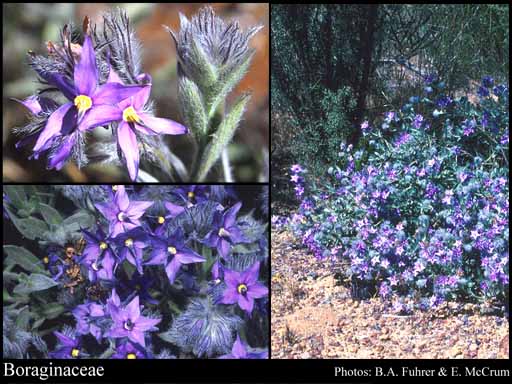- Reference
- Gen.Pl. [Jussieu] 128 (1789)
- Name Status
- Current

Scientific Description
Common name. Borage Family.
Habit and leaf form. Trees, or shrubs, or herbs, or lianas (a few); without essential oils. Autotrophic. Annual to perennial (often hispid or scabrid); plants with a basal concentration of leaves, or with neither basal nor terminal concentrations of leaves. Self supporting (usually), or climbing. Helophytic, or mesophytic, or xerophytic. Leaves minute to medium-sized; alternate, or alternate and opposite (then opposite below); petiolate to sessile; sheathing (sometimes, in basal rosettes), or non-sheathing; not gland-dotted; simple; epulvinate. Leaf blades entire; flat; usually narrow, linear to lanceolate. Leaves without stipules. Leaf blade margins entire (mostly), or crenate, or serrate, or dentate. Leaves without a persistent basal meristem. Domatia recorded, or not recorded. Leaf anatomy. Urticating hairs absent. Stem anatomy. Nodes unilacunar. Secondary thickening developing from a conventional cambial ring.
Reproductive type, pollination. Fertile flowers hermaphrodite, or functionally male, or functionally female. Unisexual flowers present, or absent. Plants hermaphrodite, or dioecious (sometimes, in Heliotropium), or gynodioecious (e.g. in Echium). Predominantly entomophilous; via hymenoptera.
Inflorescence and flower features. Flowers solitary (e.g. sometimes in Heliotropium), or aggregated in ‘inflorescences’ (usually); in cymes. The terminal inflorescence unit cymose (coiled at first). Inflorescences terminal, or axillary, or leaf-opposed; usually coiled cincinnial, sometimes double; not pseudanthial. Flowers bracteate, or ebracteate; bracteolate; usually regular, or somewhat irregular to very irregular (Echium and relatives); when irregular, zygomorphic; nearly always 5 merous (but Plagiobothrys sometimes with supernumerary K); cyclic; tetracyclic. Free hypanthium absent. Hypogynous disk present, or absent. Perianth with distinct calyx and corolla; 10(–13); 2 -whorled; isomerous (usually), or anisomerous. Calyx 5(–8) (sometimes 5–8 in Plagiobothrys); 1 -whorled; polysepalous, or gamosepalous (basally). Calyx lobes markedly shorter than the tube to markedly longer than the tube. Calyx imbricate, or open in bud, or valvate (rarely). Degree of gamosepaly, maximum length joined/total calyx length 0.1–0.5. Calyx basally appendaged (e.g. Myosurus), or neither appendaged nor spurred; persistent (nearly always), or not persistent (sometimes in Heliotropium). Corolla 5; 1 -whorled; appendiculate (often, with a corona of scales from the throat protecting the nectar), or not appendiculate; gamopetalous. Corolla lobes markedly shorter than the tube to markedly longer than the tube. Degree of gamopetaly 0.5–0.8. Corolla imbricate, or contorted; rotate, or campanulate to hypocrateriform, or tubular; regular (mostly), or regular to unequal but not bilabiate, or bilabiate (in Echium); green, or white, or cream, or yellow, or orange, or pink, or purple, or violet, or blue. Fertile stamens present, or absent (when flowers female). Androecium 5. Androecial members unbranched; adnate (to the corolla); all equal, or markedly unequal; free of one another, or coherent; 1 -whorled. Androecium exclusively of fertile stamens. Stamens 5; isomerous with the perianth; oppositisepalous (epipetalous at the mouth, or on the tube); filantherous, or with sessile anthers. Filaments appendiculate, or not appendiculate. Anthers cohering, or separate from one another, or connivent (sometimes somewhat coherent at base and apex); dorsifixed to basifixed; dehiscing via longitudinal slits; introrse; tetrasporangiate; appendaged, or unappendaged. The anther appendages when present, apical, or basal. Gynoecium 2 carpelled (usually), or 4–5 carpelled (in Trigonotis). The pistil 2 celled (rarely), or 4 celled (usually), or 10 celled (Trigonotis). Gynoecium syncarpous; synstylovarious to eu-syncarpous; superior. Ovary plurilocular; 2 locular (‘really’, but rarely ostensibly so), or 4 locular (usually, ostensibly, via false septa), or 10 locular (ostensibly, via false septa, in Trigonotis). Locules secondarily divided by ‘false septa’ (usually), or without ‘false septa’ (rarely). Gynoecium median; stylate, or non-stylate to stylate. Styles 1; from a depression at the top of the ovary; ‘gynobasic’, or apical (in Heliotropoideae). Stigmas 1–2; when simple, 1–2 - lobed; nearly always dry type; papillate; Group II type (usually), or Group III type (rarely). Placentation axile to basal. Ovules 2 per locule (i.e. per true locule), or 1 per locule (per cell, the gynoecium usually separating into one-ovuled portions); horizontal to ascending; epitropous; non-arillate; anatropous, or hemianatropous.
Fruit and seed features. Fruit fleshy, or non-fleshy; dehiscent, or indehiscent, or a schizocarp. Mericarps when schizocarpic, comprising achenes, or comprising nutlets, or comprising drupelets. Fruit when non-schizocarpic, a drupe (1–4 seeded). The drupes with separable pyrenes (two or four nutlets). Seeds endospermic, or non-endospermic. Cotyledons 2. Embryo achlorophyllous (14/17); straight, or curved. Seedling. Germination phanerocotylar, or cryptocotylar.
Physiology, biochemistry. Photosynthetic pathway: C3 and C4.
Geography, cytology, number of species. Holarctic, Paleotropical, Neotropical, Cape, Australian, and Antarctic. World distribution: cosmopolitan, but fewer in cool temperate and tropical regions, and with a strong Mediterranean concentration. X = 4–12. 2000 species.
Economic uses, etc. Ornamentals, pot herbs, dyes for wood, stone, medicines, wines and cosmetics, and some important honey plants.